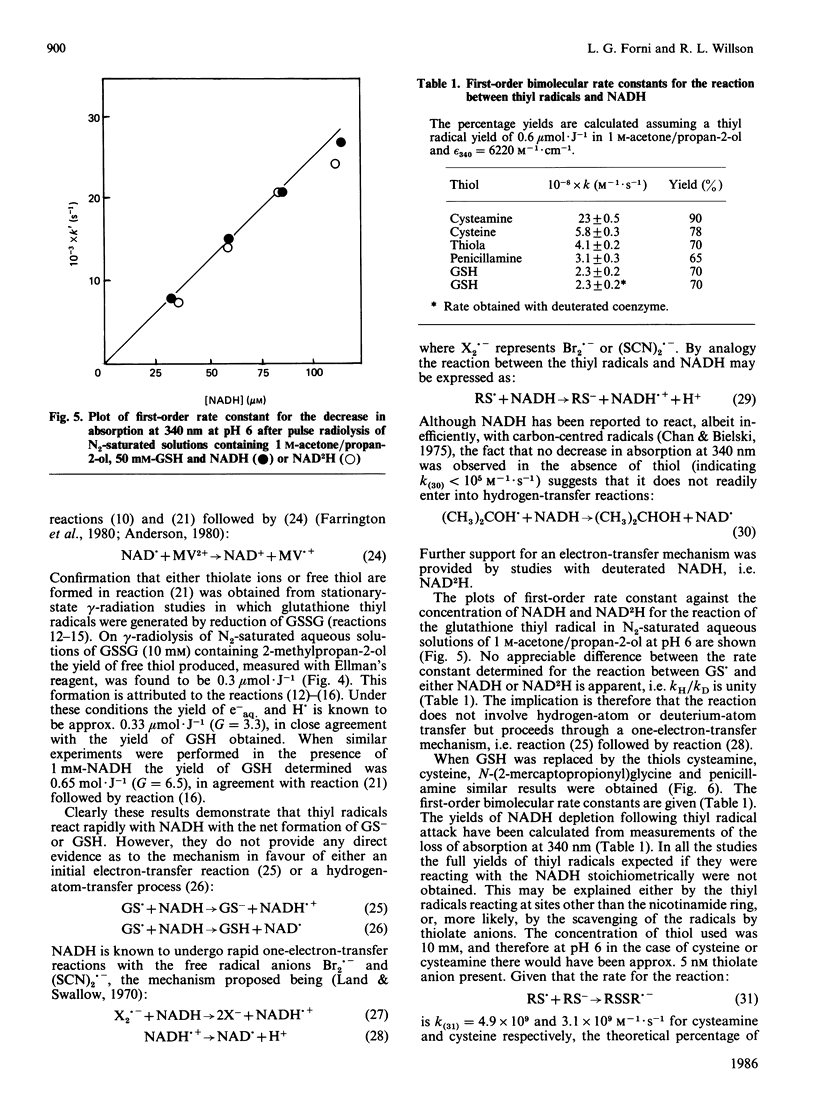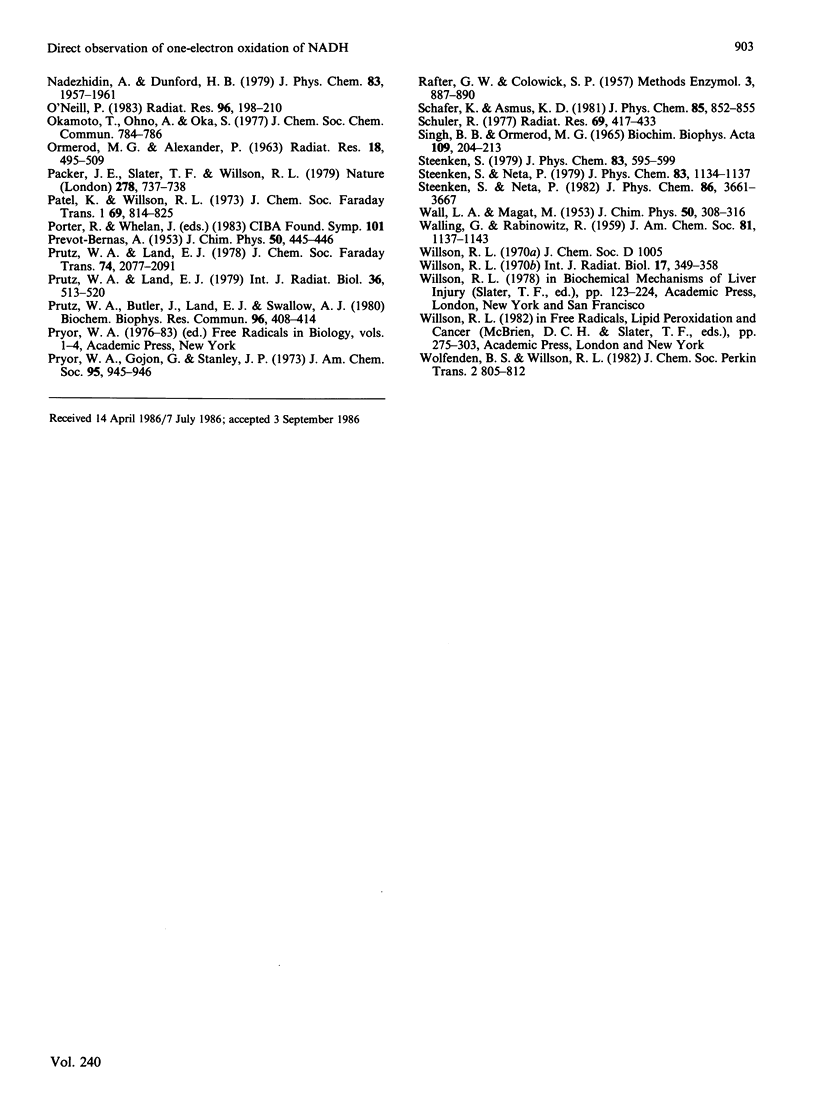Abstract
Absolute rate constants for the reaction of NADH with thiyl free radicals derived from various sulphur-containing compounds of biological significance were measured by using the technique of pulse radiolysis. These and related reactions with phenoxyl free radicals are believed to occur through one-electron-transfer processes. Further evidence comes from studies with deuterated NADH. The results support the possibility that, in biochemical systems, thiols may act as catalysts linking hydrogen-atom and electron-transfer reactions.
Full text
PDF






Selected References
These references are in PubMed. This may not be the complete list of references from this article.
- Anderson R. F. Energetics of the one-electron steps in the NAD+/NADH redox couple. Biochim Biophys Acta. 1980 Apr 2;590(2):277–281. doi: 10.1016/0005-2728(80)90032-8. [DOI] [PubMed] [Google Scholar]
- BRAAMS R. A MECHANISM FOR THE DIRECT ACTION OF IONIZING RADIATIONS. Nature. 1963 Nov 23;200:752–754. doi: 10.1038/200752a0. [DOI] [PubMed] [Google Scholar]
- Baker M. Z., Badiello R., Tamba M., Quintiliani M., Gorin G. Pulse radiolytic study of hydrogen transfer from glutathione to organic radicals. Int J Radiat Biol Relat Stud Phys Chem Med. 1982 Jun;41(6):595–602. doi: 10.1080/09553008214550691. [DOI] [PubMed] [Google Scholar]
- Chan P. C., Bielski B. H. Lactate dehydrogenase-catalyzed stereospecific hydrogen atom transfer from reduced nicotinamide adenine dinucleotide to dicarboxylate radicals. J Biol Chem. 1975 Sep 25;250(18):7266–7271. [PubMed] [Google Scholar]
- ELLMAN G. L. Tissue sulfhydryl groups. Arch Biochem Biophys. 1959 May;82(1):70–77. doi: 10.1016/0003-9861(59)90090-6. [DOI] [PubMed] [Google Scholar]
- Farrington J. A., Ebert M., Land E. J., Fletcher K. Bipyridylium quaternary salts and related compounds. V. Pulse radiolysis studies of the reaction of paraquat radical with oxygen. Implications for the mode of action of bipyridyl herbicides. Biochim Biophys Acta. 1973 Sep 26;314(3):372–381. doi: 10.1016/0005-2728(73)90121-7. [DOI] [PubMed] [Google Scholar]
- Farrington J. A., Land E. J., Swallow A. J. The one-electron reduction potentials of NAD. Biochim Biophys Acta. 1980 Apr 2;590(2):273–276. doi: 10.1016/0005-2728(80)90031-6. [DOI] [PubMed] [Google Scholar]
- Gräslund A., Ehrenberg A., Thelander L. Characterization of the free radical of mammalian ribonucleotide reductase. J Biol Chem. 1982 May 25;257(10):5711–5715. [PubMed] [Google Scholar]
- HOWARD-FLANDERS P. Effect of oxygen on the radiosensitivity of bacteriophage in the presence of sulphydryl compounds. Nature. 1960 May 7;186:485–487. doi: 10.1038/186485a0. [DOI] [PubMed] [Google Scholar]
- Land E. J., Prütz W. A. Reaction of azide radicals with amino acids and proteins. Int J Radiat Biol Relat Stud Phys Chem Med. 1979 Jul;36(1):75–83. doi: 10.1080/09553007914550831. [DOI] [PubMed] [Google Scholar]
- Land E. J., Swallow A. J. One-electron reactions in biochemical systems as studied by pulse radiolysis. IV. Oxidation of dihydronicotinamide-adenine dinucleotide. Biochim Biophys Acta. 1971 Apr 6;234(1):34–42. doi: 10.1016/0005-2728(71)90126-5. [DOI] [PubMed] [Google Scholar]
- O'Neill P. Pulse radiolytic study of the interaction of thiols and ascorbate with OH adducts of dGMP and dG: implications for DNA repair processes. Radiat Res. 1983 Oct;96(1):198–210. [PubMed] [Google Scholar]
- ORMEROD M. G., ALEXANDER P. On the mechanism of radiation protection by cysteamine: an invstigation by means of electron spin resonance. Radiat Res. 1963 Apr;18:495–509. [PubMed] [Google Scholar]
- Packer J. E., Slater T. F., Willson R. L. Direct observation of a free radical interaction between vitamin E and vitamin C. Nature. 1979 Apr 19;278(5706):737–738. doi: 10.1038/278737a0. [DOI] [PubMed] [Google Scholar]
- Prütz W. A., Butler J., Land E. J., Swallow A. J. Direct demonstration of electron transfer between tryptophan and tyrosine in proteins. Biochem Biophys Res Commun. 1980 Sep 16;96(1):408–414. doi: 10.1016/0006-291x(80)91230-9. [DOI] [PubMed] [Google Scholar]
- Prütz W. A., Land E. J. Charge transfer in peptides. Pulse radiolysis investigation of one-electron reactions in dipeptides of tryptophan and tyrosine. Int J Radiat Biol Relat Stud Phys Chem Med. 1979 Nov;36(5):513–520. doi: 10.1080/09553007914551301. [DOI] [PubMed] [Google Scholar]
- Schuler R. H. Oxidation of ascorbate anion by electron transfer to phenoxyl radicals. Radiat Res. 1977 Mar;69(3):417–433. [PubMed] [Google Scholar]
- Singh B. B., Ormerod M. G. The effect of sulphur compounds on free radical reactions and formation in irradiated dry proteins. Biochim Biophys Acta. 1965 Sep 27;109(1):204–213. doi: 10.1016/0926-6585(65)90104-4. [DOI] [PubMed] [Google Scholar]
- Willson R. L. The reaction of oxygen with radiation-induced free radicals in DNA and related compounds. Int J Radiat Biol Relat Stud Phys Chem Med. 1970;17(4):349–358. doi: 10.1080/09553007014550411. [DOI] [PubMed] [Google Scholar]


